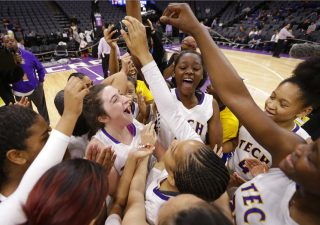Using an analysis of cellphone location data, this nationwide investigation of state lotteries found that stores that sell tickets are disproportionately clustered in lower income communities in nearly every state and that their customers come from those neighborhoods. This pattern, coupled with predatory advertising practices and powerful state lobbying efforts, is driving a multibillion-dollar wealth transfer from low-income U.S. communities to powerful multinational companies, the collaboration between the Howard Center and Boston University found.
Search Results
Unlevel Playing Fields
This collaboration between the Howard Center, The Shirley Povich Center for Sports Journalism and PBS NewsHour revealed that high school girls are still at a disadvantage nearly 50 years after Congress passed the sweeping Title IX law that guarantees equity for girls and boys in school-based athletics. In nearly a dozen stories and a national poll, the investigation illustrated girls’ second-class status, explained why the law isn’t working and examined solutions to fix the situation.
Title IX, which passed in 1972, is a federal law that prohibits sex-based discrimination at any school that receives funding from the federal government, including in sports programs. While Title IX has led to a significant increase in girls playing scholastic sports, it has fallen short of achieving equity for high school girls in areas such as facilities, equipment, scheduling and publicity, the four-month, student-led investigation found.
Printing Hate: How white-owned newspapers incited racial terror in America
From the end of Reconstruction to 1940, newspapers were the most powerful news medium in the U.S. But many printed headlines and stories that fueled racial hate, inciting massacres and lynching of Black citizens. In 36 stories, students from UMD, the University of Arkansas and five historically Black colleges and universities — Morgan State University, Howard University, North Carolina Agricultural & Technical State University, Hampton University and Morehouse College — investigated the role of newspapers that still exist today in some form. They also created an interactive database using tens of thousands of records from the Library of Congress that allows readers to look up coverage in their own backyards. They profiled some of the courageous Black journalists who provided a counternarrative to the racist white press. And they created a mini-documentary about the massacre of Black residents of Elaine, Arkansas, after sharecroppers tried to get better prices for their cotton.
Essential and Exposed
At the height of the pandemic, workplace safety systems often failed to protect workers considered essential to keeping key goods and services flowing. This series examined those failures by telling the stories of workers at Walmart, the nation’s largest employer; of foreign workers brought legally to the U.S. to pick crabs and process oysters in the Mid-Atlantic; of poultry workers in Arkansas’ chicken and turkey processors; and of health department workers who were overwhelmed by the demands on their offices in Massachusetts. The package, a collaboration among UMD, Boston University, the University of Arkansas and Stanford University, also includes a podcast telling the stories of airport workers, many behind the scenes, who risked their health to keep airplanes flying.
Saltwater Invasion
Nowhere to Go
This yearlong project, a collaboration among seven journalism schools, did deep dives into the causes and potential solutions to homelessness. The investigation told the stories of people living on the streets and people facing eviction from apartments, trailer parks and public housing during the pandemic. It documented the consequences when cities criminalize homelessness and examined whether one alternative — community courts — is effective. The Howard Center developed a suite of web scrapers to gather tens of thousands of court records from online court record management systems, and partnered with Stanford University’s Big Local News project to extend the technology for use by a wider group of journalists. In addition to Stanford, the collaboration included the University of Oregon, Boston University, the University of Arkansas, the University of Florida and Arizona State University.
Growing Up Behind Bars
The United States was the only country to condemn minors to life in prison with no chance for parole. In recent years, the Supreme Court has ruled this unconstitutional. Yet this investigation, a collaboration between the Howard Center and PBS NewsHour, found that more than 2,000 so-called juvenile lifers remain in prison in what the court says is cruel and unusual punishment.
Code Red: Baltimore’s Climate Divide
This collaboration with NPR and Wide Angle Youth Media vividly illustrated the price humans pay as the planet gets hotter. With an abundance of concrete and little shade, urban heat islands like one in Baltimore are getting hotter faster and staying hotter longer. And the people who live there are often sicker, poorer and less able to protect themselves.The investigation, using heat and humidity sensors the students built, found that rising temperatures in such neighborhoods will mean more trips to the hospital for heart, kidney and lung ailments. Drugs to treat mental illness and diabetes won’t work as well. And pregnant women will give birth to more children with more medical problems. Solutions exist. But growing more trees to undo decades of discriminatory redlining, and rebuilding streets and sidewalks to reflect the heat are expensive — and take time.








